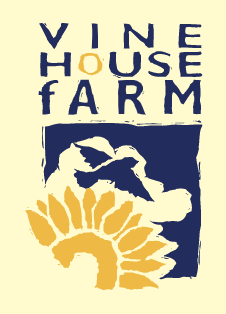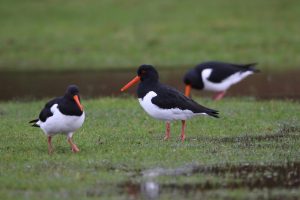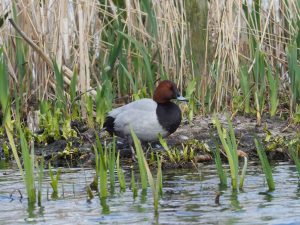
Rainfall dominated November here in the east, although it was not a disastrously wet month. We had 62.3mm against the average of 48mm, but we started the month with water everywhere. Here in south Lincolnshire, we escaped the worst downpours, but it was far too wet for us. The average temperature of 6.7°C was spot on the average for the last 50 years, but colder than the last few years. Our rainfall for the year here at Deeping St Nicholas so far is 591mm or 23.4ins, wetter than average. It would be a disastrous December if we catch up with 2019, when we had 787mm or 31ins, which was our wettest year since 1958, when we had 31.4ins.

It was a difficult month here in the east for farmers and for many it became so wet they were unable to do anything in the fields. We have been able to drill winter wheat and lift sugar beet, but our potato picking has come to a stop.
As we know, various farms in the east have been flooded, but we are told there will be no compensation for those farmers. This is despite some of those floods being caused by a lack of dredging by the government run Environment Agency.
Now is a good time to be walking along our field edges, unblocking any of the outlets of the land drains which are the three or four inch pipes that have been laid across our fields.
Wheat that was drilled a few days before the very heavy rain on the 21st and 22nd October has failed where it lay in a waterlogged soil for a few days. Those fields will have to be drilled with a spring crop such as peas, beans or barley. These spring crops are not so profitable as a crop of winter wheat and having the expense of drilling and spraying the winter wheat crops it does not look like a very profitable harvest in 2024 but you never know what is round the corner.
Before we sow our wheat, we work out which wheat markets we are aiming for. Our fenland fields do not grow quality wheats reliably, so we tend to grow wheat that ends up as chicken or pig food, as these varieties yield more. Our fields outside of the Fens will generally grow a bread making wheat; the varieties that will produce a bread making sample do not yield so much as the feed varieties. We try and grow the bread making varieties as much as we can, as we could get up to £50/tonne more for a bread making sample. This is dependent on the weather, during the last month of it ripening. Of course, all wheat will make bread but we only want to eat good quality bread, so only the best samples go to make bread.
The best bread making wheat comes from wheat sown in the spring, which doesn’t yield very well in the UK, so is not often grown here. It grows very well in Canada and we still import half a million tonnes every year, so it can be blended with our wheat to make good bread. We import less than we used to, as better bread-making varieties are now grown in the UK and the millers can add a few chemicals when needed, to make consistently good bread.


The expected arrival of Lapwings and Golden Plover during the first half of November happened. They sat on a field in Baston Fen close by the public road and were a fine sight. At their peak, there were just under 3,000 of them, with about 1,500 Lapwings. They rested on the fields by day and when dusk came, they went off to the fields to feed on invertebrates, such as slugs and worms, which normally come out in the night. Golden Plovers and Lapwings have big eyes which enable them to see in the dark. All the Golden Plover and most of the Lapwings have now moved on.
Fieldfares, Redwings and Starlings have arrived in good numbers. I thought there was close to 1,000 Fieldfares and Redwings feeding on the hedges full of hawthorn berries, which we planted for wildlife. There is more in the hedges than just hawthorn, there are also up to 10 native species of hedging plants, all of which produce berries. All the berries get eaten, except the rose hips and a few sloes.
The Starlings have mostly been probing for insects and soft grains in the soil; the frosty weather will affect them more than the Fieldfares and they may well move on if the frosty weather continues.
800 Wigeon have arrived on the wetland, but that is now frozen and they have had to go to the nearby gravel pits to find open water during the day. At night they will move on to grass or the newly sown wheat fields. Wigeon being our only grass-eating duck.
I haven’t seen many Barn Owls during the month; they will not have been enjoying the wet weather. Autumn is the time when mice come into buildings, so the Barn Owls will have been able to hunt in buildings where farmers have not had them entirely shut up. Their natural food, voles, won’t have been enjoying this wet weather either, so at the moment it’s not looking like a good vole year next year.
I cleaned out all our Tree Sparrow nest boxes in late September and by mid October some of them already had some fresh nesting material in them, meaning several of the nest boxes have already been bagged for 2024! This fresh nesting material is always at the front of the box. They are not the only species to bag their nest site in the autumn. When I drive through Langtoft village, Jackdaws are sitting on chimney pots which I presume means they’re also bagging their nest site for next year.
A good percentage of Tree Sparrows dispersed in late September from the sites where they either bred, or fledged. This just leaves those that are going to breed at the site. They were not doing that when numbers were building up on our farm between 2006 and 2017.
In 2017, more than 1,000 young Tree Sparrows were reared on the farm, but every year since, numbers have declined. Although they are still rearing nearly as many chicks per occupied nest box, they are declining because so many are dispersing and unfortunately probably dispersing to less favourable sites. There are two reasons I believe why they disperse – one could be because if a large colony stop at one site too long, they may get hit by a disease and the other reason could be that they have filled all the nest holes up with nesting material.



